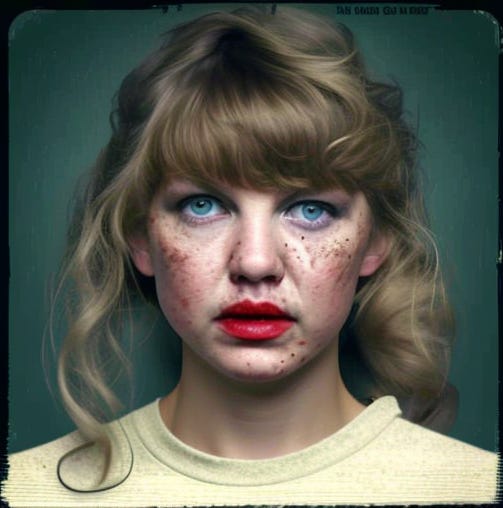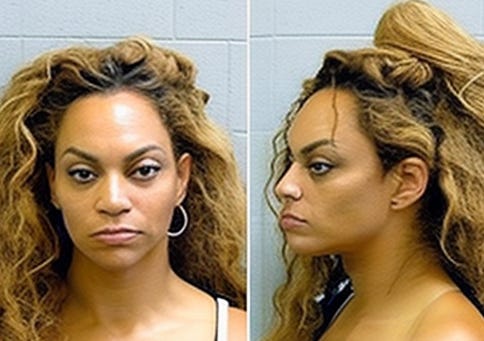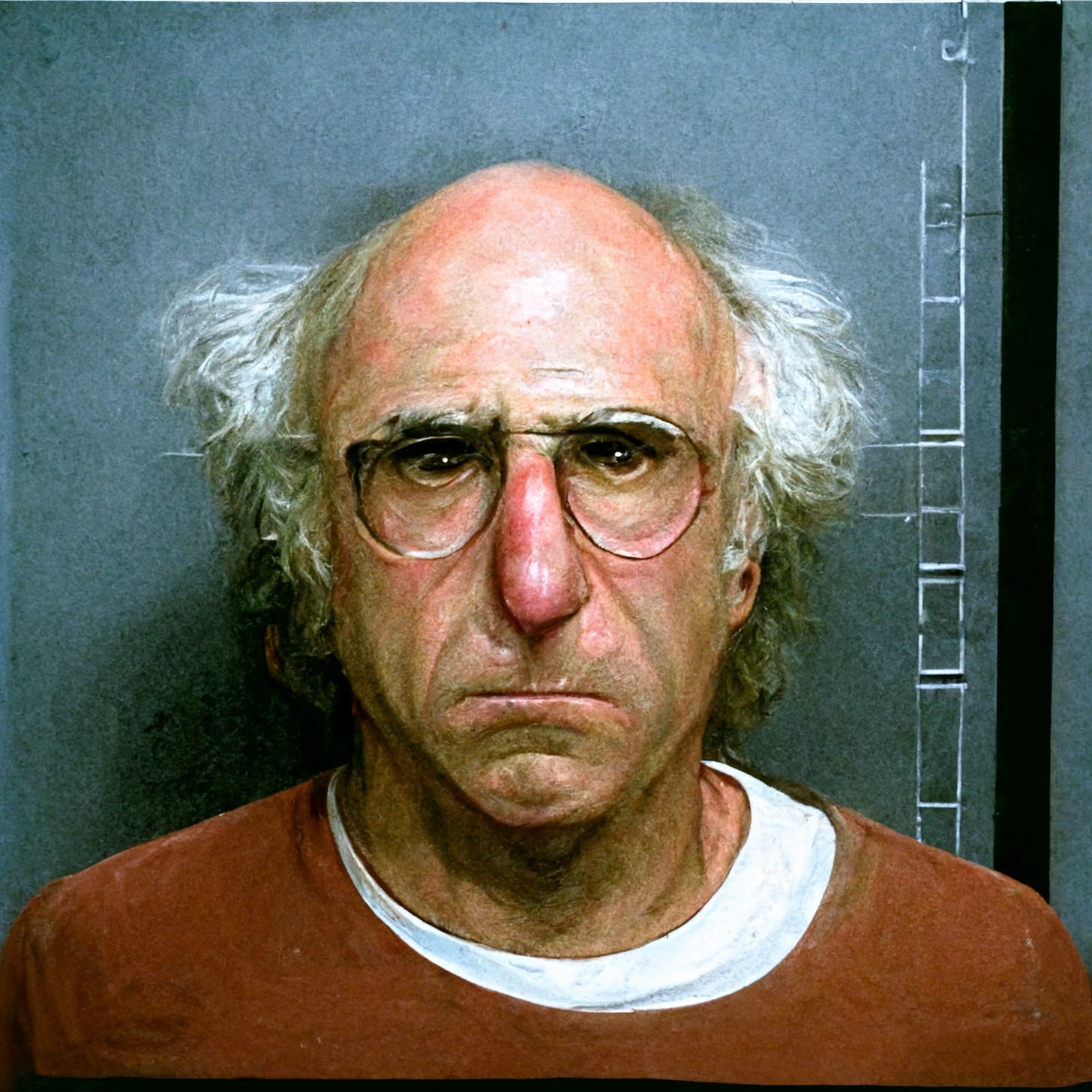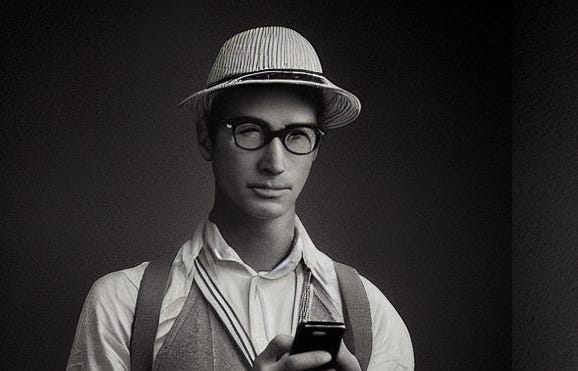The Kind of Smart Needed for Today's Web PLUS Looking Back at the Golden Age of the Internet PLUS Why Art Comes Years After Tech Arrives
“<realistic> trump mugshot for methamphetamine use,” Midjourney
The Kind of Smart Needed for Today's Web
If and when we do look back at the early 2020s, we’ll marvel at how out-of-touch journalists were. This week’s example: the LA Times earnestly asking where all the smart people will go after Twitter is actually gone. This ivory tower reading-the-room illiteracy is so unintentionally hilarious I think The Onion has finally found an insurmountable challenge to match such Marie Antoinette-level obliviousness.
Enough roasting. Where do they go when Twitter goes? Kyle Fitzpatrick is betting on TikTok, but what if that gets banned? Beckett’s recently closed, leaving many fringe literary bohemians in the lurch.Will this affect their momentum online as well, especially since many of them are Twitter personalities?
“<realistic> taylor swift mugshot for methamphetamine use with lesions on her face,” Midjourney
I can tell you where they won’t go: podcasts. Specifically the NPR-style podcasrs that welcomed them. Listeners prefer funny and chummy nowadays, marking a decidedly pre-Serial retro trend.
So, yeah, this type of smart (let’s call it “humanities-smart” and argue over its usefulness in the comments) is going to recede into the background, much like indie tastemaking became irrelevant when algorithms took over. Or how Flash animation know-how was pointless once YouTube made that irrelevant.
“<realistic> beyonce dui mugshot,” Midjourney
So what’s left? I would say a more technical kind of smart. Knowing how to write good generative AI prompts, being able to use the right type of audio for a fun Elevenlabs deepfake, etc. This will be most similar to producing your own podcast, where, yes, anyone can start a podcast, but they need the take the time and effort to learn how.
Midjourney requires money now to use. I was bored and I had ten bucks. Initially I was disappointed with the results and cancelled my subscription, but I opted to wait the month out instead of ask for a refund. I went back to Dall-E and Stable Diffusion and I was even more disappointed. Then I sat back and watched. See, when you use Midjourney, you are redirected to a Discord forum and you use html-coding-style prompts to get your images. Initially I was using <photorealistic> or <photo> to get lifelike results. Then I saw other budding prompt artists use <realistic> and I decided to use that. And that was how I made my mini-art project of celebrities being arrested for alcohol and drugs. I was compelled to do so because I was fascinated at the stark contrast between celebrities and influencers with their airbrushed, scrubbed faces on Instagram and the beaten, yet hopeful faces of my recovery friends who had smoked crack for years trying to get their lives back together. But surely, celebrities get addicted to drugs. Right, so it was as if I conjured up mugshots from the future, or a parallel universe. Even though Trump was arrested, I don’t think most people would ever expect to see these four celebrities arrested for substance abuse or DUIs. And that’s the point: anyone can be a junkie.
“<realistic> larry david mugshot drunk with swollen, red, bumpy nose,” Midjourney
I felt strongly about this project, so I kept clogging the Discord feed with different attempt after different attempt of the same pictures. When I saw an image I liked, I clicked the button to generate different versions of the one picture. Then I found the version I liked best and kept asking it to refine the picture again and again until I was satisfied. What I found interesting about this was watching other people’s creative process. Most people were OK with their first results of ironic superhero paintings or American monuments with Trump’s face on them. Either they were satisfied or they were afraid of incurring the wrath of everyone for filling the feed with similar images. I had no such compunction. I needed to see Larry David with that red alcoholic nose.
Let’s not forget that most people won’t spend the ten bucks for Midjourney and will be scared off by the slash and bracket prompts. Most will acknowledge that the Web is a young person’s game, much like bloggers like myself made way for the younger, peppier social media mavens of the 2010s.
Looking Back at the Golden Age of the Internet
But let’s look back at those days. When I began this Substack in August, I had hope that the Golden Age of the web was ahead of us. As I gradually accepted that the web will be overrun by bots, it was time I realized the Golden Age was behind us. That golden age was 2003-2015. It began when the blogosphere was starting to cohere into a concrete shape and it ended when Trump actually ran as a Republican candidate and all our feeds devolved into red-faced culture war bedlam.
One hallmark of this time: the web felt like a place that was built for our benefit (of course it never was; it was always meant to be a place to store us as data points). Or at least a place where humans were in control. Before there were algorithms, there were hipsters (or, as Peter Griffin memorably called them, “bearded failures”). The Internet in the 2000s-early 2010s was its own culture. Not everyone was on it yet. In a strange way, being online was itself a countercultural move. Normies binged Big Bang Theory and listened to Black Eyed Peas. Internet people had their own comedy (sketch videos from Human Giant and Whitest Kids U Know) and their own music (Clap Your Hands Say Yeah, Joanna Newsom). These users met in real life at comedy shows and concerts. As the Internet got bigger and their tastes got more popular, turns out their was no more subculture (unless of course you were alt-right, but that had less to do with discerning tastes than with having odious views). The Meganet had an algorithmic brain of its own and hipsters were cloned online, evolving into shitlibs.
“<50s> black and white photo of a Millenial influencer with a mobile phone dressed like a 50s dad,” Midjourney
There were many parallels between the ‘50s personality (that preached economic success with positive thinking and repressive conformity) and the 2010s manifesting influencers that loved shaming anyone who didn’t fit their moral grid. Huge difference though: the ‘50s personality was comprised of adults with children. The youth of the 2010s were like this (and are still like this of course). This may explain why micro-trends are being confused for subcultures nowadays. In the ‘50s, conformist adults consistently loved easy listening crooners. The conformist values of the youth may remain the same, but their appearance and sound change because they are still youths and, while they may not want to try different cultural values, they still need a different beat. All this has led to a divided web of preening, conformist Biden Youth and alienating, esoteric fringe Downtown scenesters who love raw eggs and HP Lovecraft/Nazi fanfiction.
Why Art Comes Years After Tech Arrives
As with any tech, AI is currently going through a hype cycle. For this reason, much of what has come out of Midjourney and Runway has been more spectacle than art. More “look what I can do” than something substantial (as you can see from my pictures above, I am not above this). This is nothing new. This is how it's always been. When sound came to film in the ‘20s, it took years for the novelty to wear off. The delirium had to die down to make space for good dialogue and film scores. Color film was invented in the early ‘30s, but we had to wait until the ‘60s for actual quality color films, when it actually seemed like it was pointless to go back to black and white. Color TV emerged in the mid ‘60s, but All in the Family and M*A*S*H were released in the early ‘70s.
Sometimes the innovations are pointless gimmicks that are symptoms of a very nervous industry. Like in the ‘50s, when Hollywood, threatened by television, released films with features like 3-D glasses and Smell-O-Vision. Yes, Hollywood was afraid. But Hollywood was also powerful enough to employ such bizarre, expensive tricks. This sounds an awful lot like Silicon Valley now. The tech lash led to the Metaverse which bombed. Same with crypto. Now AI is the new toy. There is a good chance that AI will endure, like color film did. But it will take years before we see the New Hollywood moment.









Bring back Smell-o-Vision!